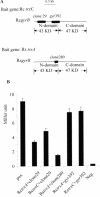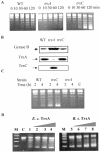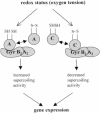Thioredoxin can influence gene expression by affecting gyrase activity
- PMID: 15328368
- PMCID: PMC516065
- DOI: 10.1093/nar/gkh794
Thioredoxin can influence gene expression by affecting gyrase activity
Abstract
The expression of many genes of facultatively photosynthetic bacteria of the genus Rhodobacter is controlled by the oxygen tension. Among these are the genes of the puf and puc operons, which encode proteins of the photosynthetic apparatus. Previous results revealed that thioredoxins are involved in the regulated expression of these operons, but it remained unsolved as to the mechanisms by which thioredoxins affect puf and puc expression. Here we show that reduced TrxA of Rhodobacter capsulatus and Rhodobacter sphaeroides and oxidized TrxC of R.capsulatus interact with DNA gyrase and alter its DNA supercoiling activity. While TrxA enhances supercoiling, TrxC exerts a negative effect on this activity. Furthermore, inhibition of gyrase activity strongly reduces puf and puc expression. Our results reveal a new signaling pathway by which oxygen can affect the expression of bacterial genes.
Figures








Similar articles
-
Thioredoxin 2 is involved in oxidative stress defence and redox-dependent expression of photosynthesis genes in Rhodobacter capsulatus.Microbiology (Reading). 2003 Feb;149(Pt 2):419-430. doi: 10.1099/mic.0.25978-0. Microbiology (Reading). 2003. PMID: 12624204
-
Thioredoxin is involved in oxygen-regulated formation of the photosynthetic apparatus of Rhodobacter sphaeroides.J Bacteriol. 1999 Jan;181(1):100-6. doi: 10.1128/JB.181.1.100-106.1999. J Bacteriol. 1999. PMID: 9864318 Free PMC article.
-
Bacteriochlorophyll-dependent expression of genes for pigment-binding proteins in Rhodobacter capsulatus involves the RegB/RegA two-component system.Mol Genet Genomics. 2002 Apr;267(2):202-9. doi: 10.1007/s00438-002-0652-y. Epub 2002 Mar 2. Mol Genet Genomics. 2002. PMID: 11976963
-
Oxygen-regulated expression of genes for pigment binding proteins in Rhodobacter capsulatus.J Mol Microbiol Biotechnol. 2002 May;4(3):249-53. J Mol Microbiol Biotechnol. 2002. PMID: 11931555 Review.
-
The role of mRNA degradation in the regulated expression of bacterial photosynthesis genes.Mol Microbiol. 1993 Jul;9(1):1-7. doi: 10.1111/j.1365-2958.1993.tb01663.x. Mol Microbiol. 1993. PMID: 7692215 Review.
Cited by
-
Hydrogen Sulfide From Cysteine Desulfurase, Not 3-Mercaptopyruvate Sulfurtransferase, Contributes to Sustaining Cell Growth and Bioenergetics in E. coli Under Anaerobic Conditions.Front Microbiol. 2019 Oct 11;10:2357. doi: 10.3389/fmicb.2019.02357. eCollection 2019. Front Microbiol. 2019. PMID: 31681220 Free PMC article.
-
YacG from Escherichia coli is a specific endogenous inhibitor of DNA gyrase.Nucleic Acids Res. 2008 Aug;36(13):4310-6. doi: 10.1093/nar/gkn355. Epub 2008 Jun 27. Nucleic Acids Res. 2008. PMID: 18586829 Free PMC article.
-
Thioredoxins in bacteria: functions in oxidative stress response and regulation of thioredoxin genes.Naturwissenschaften. 2006 Jun;93(6):259-66. doi: 10.1007/s00114-006-0106-1. Naturwissenschaften. 2006. PMID: 16555095 Review.
-
Glutamate racemase from Mycobacterium tuberculosis inhibits DNA gyrase by affecting its DNA-binding.Nucleic Acids Res. 2006;34(19):5567-76. doi: 10.1093/nar/gkl704. Epub 2006 Oct 4. Nucleic Acids Res. 2006. PMID: 17020913 Free PMC article.
-
Expression of the trxC gene of Rhodobacter capsulatus: response to cellular redox status is mediated by the transcriptional regulator OxyR.J Bacteriol. 2006 Nov;188(21):7689-95. doi: 10.1128/JB.00660-06. Epub 2006 Aug 17. J Bacteriol. 2006. PMID: 16916895 Free PMC article.
References
-
- Laurent T.C., Moore,E.C. and Reichard,P. (1964) Enzymatic synthesis of deoxyribonucleotides. IV. Isolation and characterization of thioredoxin, the hydrogen donor from Escherichia coli. J. Biol. Chem., 239, 3436–3444. - PubMed
-
- Holmgren A. (1984) Enzymatic reduction–oxidation of protein disulfides by thioredoxin. Methods Enzymol., 107, 295–300. - PubMed
-
- Carmel-Harel O. and Storz,G. (2000) Roles of the glutathione- and thioredoxin-dependent reduction systems in the Escherichia coli and Saccharomyces cerevisiae responses to oxidative stress. Annu. Rev. Microbiol., 54, 439–461. - PubMed
-
- Ritz D. and Beckwith,J. (2001) Roles of thiol-redox pathways in bacteria. Annu. Rev. Microbiol., 55, 21–48. - PubMed
-
- Schulze-Osthoff K., Schenk,H. and Droge,W. (1995) Effects of thioredoxin on activation of transcription factor NF-kappa B. Methods Enzymol., 252, 253–264. - PubMed
Publication types
MeSH terms
Substances
Grants and funding
LinkOut - more resources
Full Text Sources
Other Literature Sources

